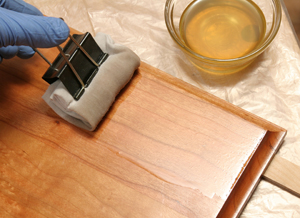
The question is, “How thick is a wiped on finish?” I know that it seems really stupid, but there is a reason. I have a project where two adjacent pieces of wood are going to move. It would be very undesirable for these pieces to squeak when moving. The two pieces of wood need to be finished and, by knowing the finish thickness, I can design the pieces so that they don’t touch. I know what you’re thinking, but I never had any marbles to start with.
The project is a platform bed built using a series of boxes to support the mattress. The boxes are bolted together and will have storage drawers. I think that now you understand why squeaking is undesirable. The actual structural connections have the squeaking issue resolved, but the aesthetic details are where the squeaking would be a problem. Thanks for your help. – Rich Flynn
Rob Johnstone: Oh, Rich, my friend … my first thought, and I mean this sincerely, is that if you are worrying about the thickness of your finish affecting things, you are working way too hard. With that off my chest, I wonder if you need to finish the touching aspects of the headboard at all. Put finish on the show faces and seal the areas of your construction where the wood may touch with wax. That way, even if the boards do touch, the wax will lubricate rather than squeak.
Tim Inman: I actually own sensitive electronic equipment that will allow me to measure both the wet film and dry film thickness of finishes on wood. I do; I can. Why? Because, in another life I was very involved in the design and manufacture of wood finishes which our companies made for the use of fine furniture finishers and antique restorers. For that purpose, I needed to know exactly what the film performance characteristics were. I’m working hard to be “more retired” now, so I have those instruments more as mementos of times gone by — and for teaching demonstrations. For actual work in the shop, there is really not much need to know these things.
My input on your project is this: Your desire to know the dry film thickness of a particular finish hinges on the idea that wood is characteristically dimensionally stable, and that it will remain stable over a period of time. It also assumes that your equipment and/or skill can produce tolerances which would accommodate the thickness of the dry film and no more or no less. Both of these assumptions are, in my view, unhelpful.
Wood moves. It swells and shrinks with moisture exchanges. It swells and shrinks with temperature changes. As woodworkers, we must deal with our materials and their inherent variables. We cannot ignore them or hope they were different. Wood is wood. We’re woodworkers, not machinists. I’ve been working with old furniture for many decades. In that time, one of my “pet peeves” is ill-fitting, dragging doors and drawers. Something that should move or fit that, instead, drags or sticks just irks me to no end! Allow plenty of clearance when you make your project. It will only reward you later. Fit the moving parts too closely in the beginning and they will, over time, relax and swell or twist, and begin to drag and stick. You will be upset.
An ordinary playing card is about .012 thick (twelve thousandths of an inch). I use a playing card quite often as a thickness gauge in my shop. A playing card between the drawer sides and the tracks/runners seems to be about right. A playing card under the doors and on the top is, again, about right. You can fit things closer — but they’ll soon begin to drag. If you get the fit too sloppy (within reason) it won’t be noticed much. Err on the “too loose” side. But, to answer your question: A dry film coating of most finishes will spec out at about 1.5 to 2 thousandths, maybe up to 3 or 4. An oil film will leave virtually no measurable film.





